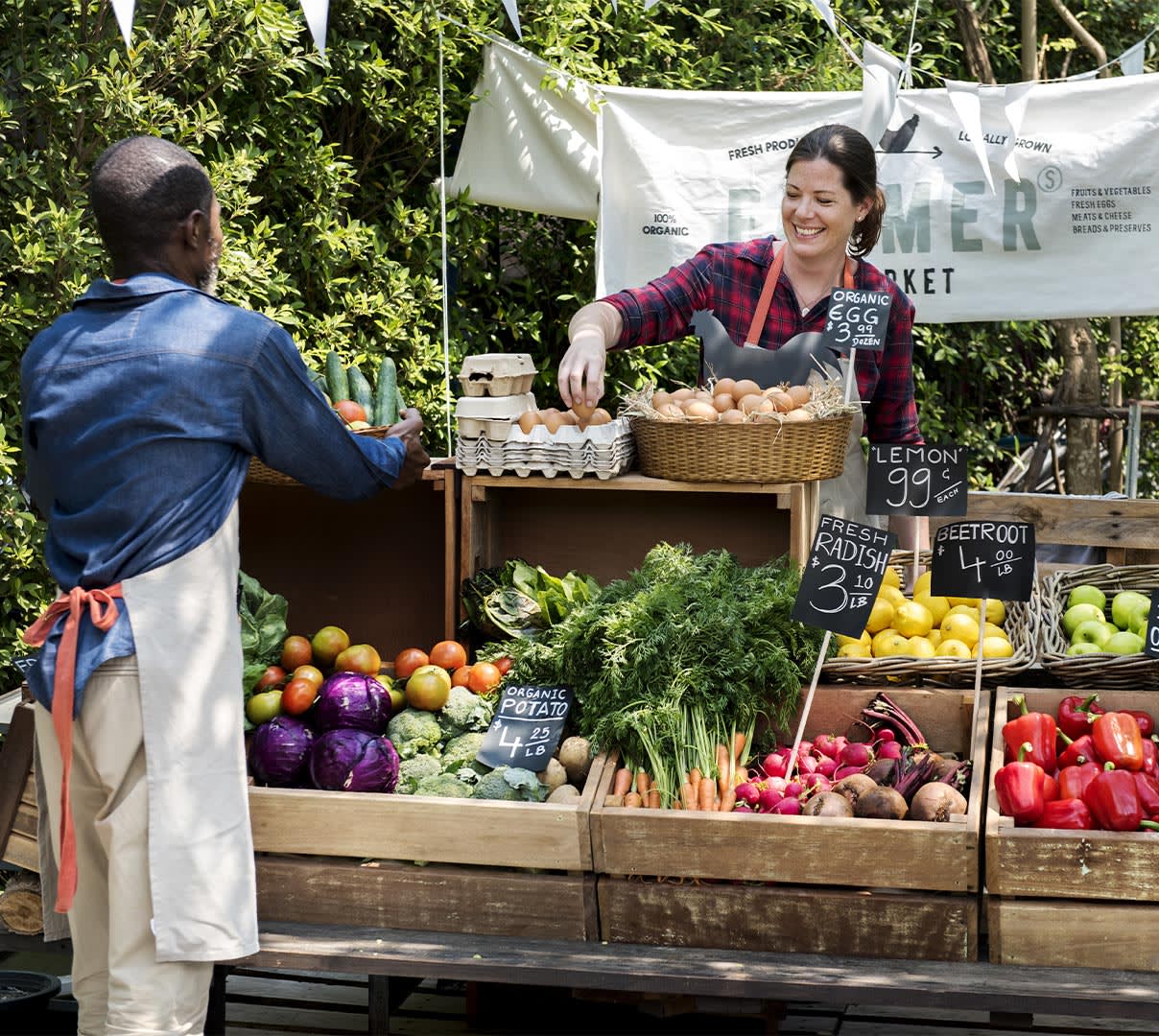Local vendors and suppliers, big and small, are at the center of any community. To tap into this resource and nurture local community connections, restaurants are increasingly focused on sourcing locally. This includes raw ingredients, ready-to-eat foods, and even paper goods.
Customers are also prioritizing purchasing locally-sourced food. This aligns with various food movements — including the farm-to-table movement, which advocates for ethically sourced, organic, and locally produced food, and the locavore movement, which involves consuming locally-grown or produced food. Additionally, the slow food movement emphasizes the importance of eating food that is not only delicious but also adheres to principles of sustainability and equity.
All these movements share a common desire among customers — the curiosity to know where their food comes from. To thrive in the current landscape and cater to socially conscious consumers, restaurants are increasingly partnering with local food suppliers.
Vancouver restaurateur Asha Wheeldon, the founder of Kula Kitchen, highlights this vital connection between food and people. “I’m from Kenya, and one of the first values I learned was around connection through sharing space, sharing resources. Food allowed me to connect with the community.”

Why you should work with local vendors
When restaurants source ingredients and products from local vendors and suppliers, they craft meaningful relationships and strengthen community bonds. From quick-service to fine dining, restaurants of all types can choose to support local producers and farmers and ensure their menu uses the freshest and highest-quality ingredients. Restaurants will often credit the local vendor in the menu item description, so customers can feel good about where the ingredients are sourced from.

Types of local producers to consider
There are multiple avenues to consider when sourcing for restaurants. Local farmers who grow fruits and vegetables, producers who make wine or beer, and bakers who supply bread or pastries can all be tapped to contribute ingredients for a restaurant menu. Additionally, looking to local food distributors such as farmers’ institutes and co-ops can contribute to unique and creative menu offerings.
Justin Rosenberg, the founder and CEO of Honeygrow, stresses the importance of whole-food dishes that are, when possible, locally sourced in a sustainable way. "When you use local ingredients, it shortens the time between harvest and serving so the taste and color will be better," he says.
Some of the most common local food vendors for restaurants to purchase key ingredients from are:
Bakeries
From bread to pastries to custom desserts, bakeries offer a wide range of artisanal products, and a commercial bakery is likely to have the right equipment to scale.
Butchers
Local butchers can be a great resource for specialty products, including grass-fed, organic, antibiotic-free, and pasture-raised meats.
Farmers
Sourcing local fruits and vegetables means a greater focus on fresh, in-season produce that supports local food security and long-term sustainability.
Seafood suppliers
Freshness is paramount with fish and seafood. Sourcing locally means accessing non-farmed, non-frozen seafood that does not need to be imported, while also economically supporting small-scale local fishers in your area.
Creameries and cheesemakers
Local dairy farmers have long been a cornerstone of many communities, and offer a wide variety of milk, cream, yogurt, and cheeses, including products without added hormones.
Apiaries
Compared to imported honey from far afield, local apiaries focus on quality, including seasonal honey derived from different flower sources.
Breweries, wineries, and cideries
The enduring popularity of craft breweries, cideries, and wineries — with their broad and diverse roster of products — offers the opportunity to collaborate on seasonal products, special offers, and promotions.
Local suppliers offer more than just food
Producers and suppliers also specialize in non-food items such as paper goods, cleaning products, takeout containers, and tablewares, offering unique and often eco-responsible options to help restaurants reduce their environmental footprint — a benefit valued by millennial and Gen Z customers, who increasingly make purchase decisions based on environmental impact.
Partnering with local artisans for one-of-a-kind items can add to the character and ambiance of a restaurant. For example, handcrafted crockery or paintings by community artists can enhance the overall dining experience and perceived brand value.
How to find food suppliers for a restaurant
Sourcing locally begins with networking. Visit your favorite community spots, like bakeries or breweries, and ask to speak to the managing staff about potential restaurant partnerships. When you visit the farmer’s market, talk with the local producers to see if there’s interest in working together.
Local business groups and networking
Participate in local networking events and trade shows to meet potential food suppliers for restaurants. Plus, contacting local groups such as a chamber of commerce, economic development commission, or Rotary Club expands your network and builds community trust. Cross-promote unique products or offers with nearby businesses, and explore collaborations with schools and nonprofits to strengthen community ties and find unique marketing opportunities.
Social media
Social media is a powerful tool for connection. You can attract local artisans, vendors, and customers using location-based hashtags. Social media also offers a platform for restaurants to share stories about their product, events, and partnerships with local suppliers to increase community support. It can also make local vendors more inclined to collaborate, as they recognize your business is part of their community.
Local vendors fuel creativity and collaboration
The potential for innovation and creative partnership abounds within communities. From ice cream parlors using a brewery’s craft beer to create a new flavor to a cafe carrying hand-poured candles from the general store — there are countless ways restaurants and other local businesses or vendors can come together to support each other authentically.
Collaborating with local suppliers can present great marketing opportunities. When two businesses that don’t necessarily share the same customer base come together to collaborate on a pop-up or a new dish, it’s an opportunity to create a special campaign to entice new customers.
Dashers are a vital community connection, too
Building relationships with local producers also includes DoorDash’s network of Dashers, who are an essential connection between restaurants and their communities. It’s important that the community-building your restaurant does with its staff and neighboring businesses extends to Dashers, who also facilitate connection in their community.

DoorDash helps embody the spirit of family in our business through its driver community. I always emphasize to our team to treat our DoorDash drivers as well as our guests. They’re part of our family, part of our success, part of our story — and we’re very thankful for them.
The more Dashers feel valued, the more value they will bring to restaurants and the broader community. As Teresa Cerino of Geneva, New York’s Water St. Cafe notes, a crucial part of the cafe’s success has been thoughtfully cultivating positive relationships with Dashers. “We’re a small business,” says Cerino. “The Dashers are truly an extension of our restaurant — they really represent us. It’s not just another service; they’re making sure our customers have a good experience.”

Start building community today
Supporting local producers and vendors is a great way for restaurants and other small businesses to foster a strong and interconnected community. By sourcing ingredients locally, restaurants can ensure freshness, quality, and sustainability, all while cultivating meaningful relationships with suppliers.
By embracing the values of movements like farm-to-table and slow food, restaurants can meet the increasing demand for ethically sourced and locally produced food. These collective efforts contribute to a thriving local economy, attract sustainably-focused consumers, and foster a more vibrant community.
Interested in reaching more diners in your community? Learn how DoorDash can help introduce your restaurant to new customers in your area through delivery and pickup.





